DO not buy a knee sleeve out of this list. This is the most researched and well sought after list on the internet for the best knee sleeves for running and sports. These are some of the industry best knee sleeves but also have some amazing user reviews. Because consumer is our almost priority, its important for us to understand and take into consideration on what the users are talking about. So here is the list of top 10 best knee sleeves/braces for running and sports.
Remember taking care of your knee is very important for you and also your family because your movement depends on it. This article will be the most detailed article you will read about Human knee, If you go below a bit, you will find out all about human knee, like what cause issues, what are the treatments and what are the most common problems.
How to measure correctly for the knee size:
One of the major problems of knee sleeves is the sizes, it comes with different knee sizes to cater thousands of people around the world but you have different sizes. So, the best way to measure the knee size is to measure it 4 inches about the knee cap. You have to measure the circumference of the leg.
Remember that some of the companies might have a different measuring method so always remember to read the measurement method before ordering.
Remember to see the best compression socks for running as well for a great all in one kit. Shoes and insoles also play a vital role in your posture maintenance, so don’t get carried away with only Knee sleeves.
Types of KNEE pain:
Why to use compression knee sleeves for knee pain?
Compression knee sleeves are therapeutic garments that are designed to reduce the risk of injury while providing support to the muscles and joints. These sleeves can help relieve pain and swelling in your knees while also improving circulation. They provide stabilization for major muscle groups in the leg, reducing the risk of injury during certain sports or strenuous activities.
Most Common Knee Injuries
The human knee is mostly used joint and commonly injured during different activities. It plays an important role in supporting the body’s movement, facilitating movements and allowing the body to bend and raise easily. Some of the most common knee injuries can happen during sports activities, exercising, working while kneeling down most of the time, accidents, sudden shocks to the knee joint, and tearing the muscles.
Tearing the muscle, ligaments, tendons, and cartilage can cause some of the most common injuries. Let’s look at some of the most common injuries that cause knee pain.
1. Sprains and Strains
An Injury that happens to the ligament cause sprain and strain. ACL and MCL are the ligaments that injure most often. Sprains and strains can mostly happen during sports such as while playing soccer, basketball, and football. During these sports, the knee can experience sudden stop, twisting movement, improper landing from a jump or sudden change in direction.
A pop sound or snap and knee pain may be experience followed by the instant swallowed knee. Symptoms may include swelling, pain while walking and tenderness of the joint.
2. Fractures
A fracture most commonly caused by trauma such as sudden falls during sports activities and accidents. The bones in and around the knee can be fractured. The most commonly injured bone in the joint is patella or kneecap. The patella works as a shield for the knee joint. Damaging the kneecap or patella during a high impact fall or sports injury can cause a fracture to the joint and knee pain. Stepping in the wrong way or tripping while having osteoporosis may fracture the knees as well.
3. Dislocation of the Knee
The dislocation of the knee occurs when the kneecap slides out of the position. One or more of the knee bones may slip out of place followed by a swollen painful knee. Major traumas such as fall, high-speed impact, contact sports or car accident can cause knee pain and dislocation of the knee. Structural abnormalities can cause the knee bones out of their proper alignment and placement.
Dislocations require relocation. Sometimes the kneecap return to the proper position itself and will correct automatically. Generally, six weeks are required to fully heal the dislocation injury. Otherwise, relocating the kneecap can be done by the doctor without causing too much discomfort.
4. Meniscus Tear
Meniscus tear happens when the knee gets twist, bend, and pivots during the sports generally. When a torn cartilage is diagnosed in the knee, it happens to be a meniscus tear. The pieces of cartilages can tear during sports activities suddenly. But it can also happen slowly due to aging. A pop sound can be heard and felt in the knee when a meniscus tear happens suddenly. The injury can lead to pain, swelling, and tightness and may increase over the next days. Surgery may be required depending on the severity of the tear.
5. Tendon Tears
The patellar tendons work together with the muscles and help straighten the leg. Torn patellar tendons are most common among middle-aged people. It can also happen during playing sports. Direct impact from a hit or fall can cause knee pain and a tear in tendons. It is possible for anyone to have torn patellar tendons. Initially, a torn patellar tendon require rest and physical therapy to heal. But if the tear is considered as an injury it may require surgery to function completely.
6. Anterior Cruciate Ligament Injuries (ACL)
ACL is a knee tissue that helps the knee wit stability. A twisted leg or lower leg extension beyond its limits can result in torn ACL. It is a sports-related knee injury and is one of the most common knee injuries. Athletes who participate in contact sports such as football, basketball or soccer often injure their ACLs.
Causes: Improper landing from a jump or quickly changing the direction of motion can lead to a torn ACL. It can increase from a small tear to a severe injury if the ligament is completely torn and becomes separated from the bone itself. Treatment option depends on the severity of the injury. Physical rehabilitation is recommended often after tearing ACL.
7. Posterior Cruciate Ligament Injuries (PCL)
This ligament is located at the back of the knee. A PCL injury occurs with a sudden trauma while bending the knee suddenly during sports activities. Falling hard on a bent knee or in an accident that impacts the knee when bent can cause the torn PCL ligament with knee pain. A PCL injury that only has torn ligament is generally non-surgical. But if there are injuries more than one then surgery may require.
8. Collateral Ligament Injuries
Injuries to these ligaments is a common problem in those who involve in contact sports. Collateral ligament injury can happen due to a direct impact or collision with an object or a person. Tearing this ligament is easy when the lower leg is forced sideways. Treating this injury requires non-surgery treatment. But if there are other fractures or injuries in the knee then a surgical procedure may help to heal completely.
9. Bursitis
Bursae are small fluid-filled sacs that work as a cushion between the knee joints. They allow the tendons and ligaments to slide easily. Repeated pressure from kneeling and overusing the knee joint can cause swelling and inflammation in the sacs and knee pain. Bursa injuries are not serious and can be treated by self-care. However, some instances may require antibiotic, treatment or aspiration. Doctors call this patellar bursitis.
10. Overuse
An overuse injury is known as ‘runner’s knee’. Runner’s and cyclists are the painful conditions that are common among young individuals and athletes. This injury can cause pain behind and around the knee and the kneecap and can even travel to the thigh. The pain can be relieved by rest and worsens with activities.
11. Iliotibial Band Syndrome (IT)
The iliotibial (IT) band is a piece of tough tissue that is located on the outside of the knee. IT band syndrome is common among long-distance runners. With overdo activities it can become inflamed. It may cause pain on the outer side of the knee. Typically the pain starts off as a minor irritation. When this syndrome happens a runner must stop running and wait until iliotibial band heals.
12. Osgood-Schlatter Disease
This condition happens in young individuals when they are having changes in bones and other parts of the knee. This is especially common in teenage girls and boys. It can cause a painful knee with a bump under the knee. Overdoing exercise, bending while picking up pets such as cat, dogs and irritation often make this area hurt. The pain may come and go over time.
Top 8 Best knee sleeves detailed review below:
Best 8 knee sleeves for running and sports Detail review:
Below are my best compression knee sleeves for running list and I am sure you are going to find one best fit for you. I have researched the best one’s for you so you don;t have to take risk.
1. UFlex Athletics Knee Compression Sleeve Support
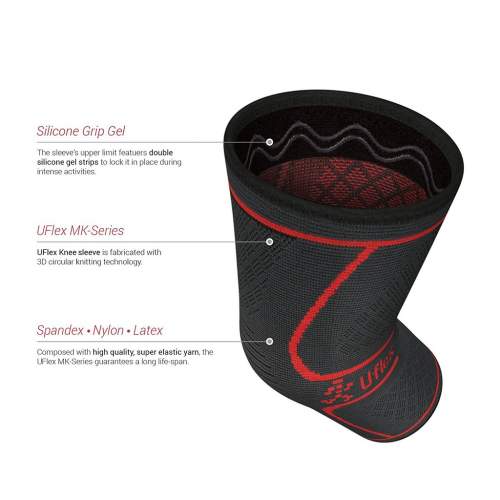
One of the best sellers and reviewed knee sleeve in the market, this one really gives you the bang for the buck. Some of the main features you need to know are the silicone grip gel, which is a magical thing in this type of product, what it does it as soon as you start sweating, it will lock it self to the skin more tighter so as much intense activity you do, it makes more protected grip.
It comes with a very high stretchable protected fabric which is good specially in sports or running. Its good for inflammation and swelling and has a great heating effect.
2. POWERLIX Knee Compression Sleeve
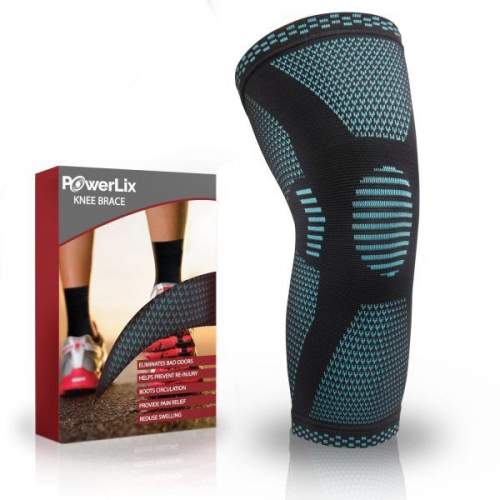
It comes with a 360 degree protection to your knee, the best feature to talk about here is the all day long usage. It has such a comfortable yet secure grip that you can use this thing all day long with out even thinking you are wearing something.
Its fabric is good quality and with long term usage does not looses out as many of the knee sleeves do. It also comes with a great anti slip protection gel grip which makes it even more secure while running or playing any kind of sport. You can almost play any sports with it, you name it like basketball, volleyball etc.
It has 4-way compression so that you feel the pressure from all around which is actually really good for you while running or playing.
3. Crucial compression Knee Brace Compression Sleeve

Our third choice comes from a company called crucial compression, this comes in three different colors and is great for running and sports. Not only this it can be good for ACL, MCL or arthritis. People call it the best knee sleeves for basketball but we know it can be used in any other sports.
As one of the most demanded features, the anti slip technology comes with it which is called, “No slip double grip” they have doubled the grip for even better protection. Some of the important things which people are liking about the knee sleeve is the weight, its so light and breathable that no one notices it after wearing it for some time.
If you properly read the size list they have mentioned you will have no problem in the size as their size chart is really nice and easy to understand.
4. CAMBIVO 2 Pack Knee Brace, Knee Compression Sleeve
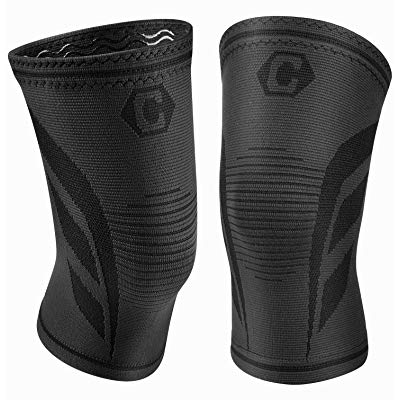
One of the most talked about features of this one other than its good quality is the wide range of color options it comes with. We are sure you will like one of the color options it has. Great for running and sports. Its comes with the flexible and breathable fabric with a great grip because of 3D thread technology.
Its also great for meniscus tear and joint pain, as of the time of writing it also comes with a free ebook give away about knee pain and about how to take care of the knee. And its great deal for people who want to have knee sleeves for old people.
5. ProFitness 7MM Knee Sleeve (Pair)

This knee sleeve has the most positive reviews specially for running and squatting plus any kind of gym work out. It comes with 7mm neoprene fabric which is great for maximum performance while securing your knees from injuries. When it says 100 percent satisfaction guarantee, it means it.
It comes with a heavy-duty performance fabric for maximum durability. Comes with 4 different colors and the front height is almost 10 inches which is a perfect fit for most of the people. Back is 8 inches. Also comes with anti-slip gel.
Price may be a little higher than the other ones here but its really worth it. Keeping price in consideration it could not top the list but it’s a great contender.
6. BLITZU Flex Plus Compression Knee Brace Men and Women
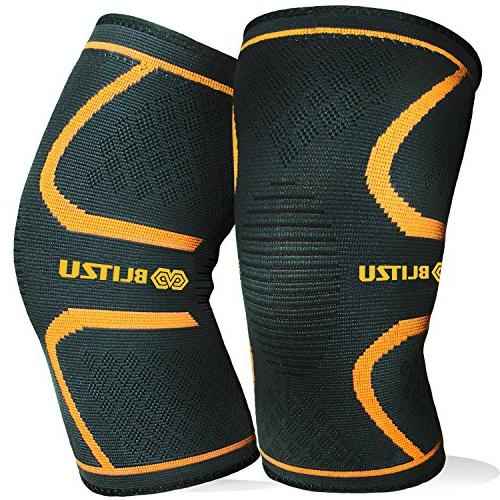
It comes with two options either 7mm or 5mm neoprene fabric material with some great features, like protection of knees while running or workout, great for joint pain or ACL and MCL.
Comes in a pair so you don’t have to buy two separate ones, has three very attractive color options to choose from. Some of the great features include effective reduction of inflammation. Enhanced knee stability with a great build and joint flexibility.
Knee warm up for improved circulation of blood, great grip and good quality fabric. It is designed for every day use so its light and durable.
7. Physix Gear Knee Support Brace – Premium Recovery & Compression Sleeve
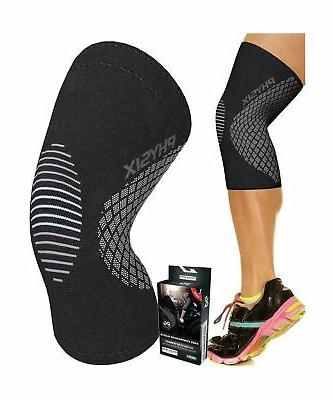
Designed with a very durable fabric which is stitched with 4 way breathable and stretchable material which makes it a great fit for everyday use. One of the best features of it are the resistance to usage. Even if you use it day and night, it will not loosen up and fall down like many others.
It comes with graduated compression which allows best performance while not caring about your knee. Also comes with the same anti slip gel for worry free run. Made with nylon and Lycra for extreme performance. Graduated compression means it has less compression on lower side and more compression on upper side of the sleeve. Comes with many attractive color options.
8. Sable Knee Brace Support Compression Sleeves for Men and Women
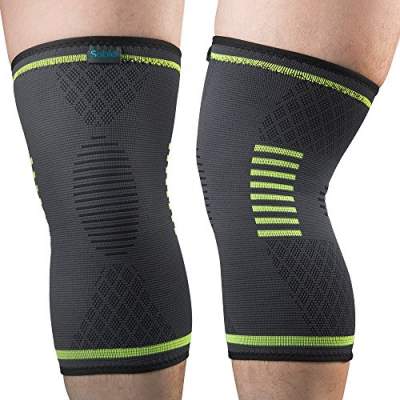
It supports full range motion so you can run, play sports or do your routine workout. Hiking? No worries you are covered. This knee sleeve comes with a mix of breathable fabric to give you extra comfort.
Exclusive knitting technology makes it great for everyday wear. It is great for regular use with great feedback from customers. Comes with anti slip tech.
Care to share! Best and honest reviews on the internet
How to wear knee sleeves properly?
ALL ABOUT THE HUMAN KNEE
The knee joint is part of the lower extremity. It is a hinge joint which is responsible for movement and weight-bearing. It is a complex structure and one of the most stressed joints in the body. The knee joint is the largest joint that supports the body in an upright position. It provides stability and acts as a shock absorber. An injury to this joint can cause severe knee pain.

The Knee Joint
The knee joins together the thigh bone, shin bone, fibula, and kneecap. The normal anatomy of the knee can help understand the conditions that cause problems of the knee. The knee consists of bones, tendons, muscles, and ligaments. Below you will be able to understand the anatomy of the knee joint along with the detail discussion of every part of the knee.
Anatomy of the Human Knee
The knee is the largest joint in the human body. It is a hinge joint that allows flexibility and slight rotation to move around smoothly. The human knee joins the thigh with leg and consists of two joints. One of them is tibiofemoral joint which is between the femur and tibia. The other one is patella femoral joint and is in between the femur and patella. The human knee consists of:
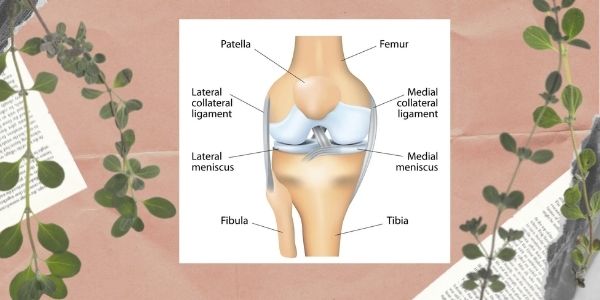
• Bones
• Cartilage
• Ligaments
• Tendons
Human knee Bones
The human knee consist of four bones:
• Femur
• Tibia
• Patella
• Fibula
1. The Femur is the thigh bone which is the longest and strongest bone in the body. The round knobs near the knee are called condyles. The long straight part of the femur is called the femoral shaft. The end of the femur within the knee joint is covered in articular cartilage.
2. The Tibia is known as the shinbone or shank bone runs from the knee to ankle. The tibia is anterior of the two bones in the leg below the knee in vertebrates. In the knee joint, there are two C-shaped shock-absorbing cartilages called menisci.
3. The Patella is a small, semi-flat triangular bone that is able to move the knee when bending. This bone sits at the front of the knee in the quadriceps muscle. If the patella is break or fracture, the quadriceps muscle may not be able to effectively pull on the tibia, which can make difficult to straighten the knee. Lined with the thickest layer of cartilage in the bod, the patella endures a great deal of force.
4. The Fibula is a small bone that is often located behind the knee joint. It is a long thin bone in the lower leg on the lateral side. The fibula runs alongside the tibia from the knee to the ankle. It serves as an attachment for the muscle and helps to form the ankle joint. This bone is found in about 25% of the population.
The Cartilage of the Human Knee
There are many types of cartilage in the human body with different functions. But there are two types of cartilages in the human knee. The articular cartilage is a smooth lining that covers the end of the knee bone. It is a thin shiny layer of the cartilage on the femur, the top of the tibia and the back of the patella. Warning away this cartilage results in knee arthritis.
The other type of cartilage is called the meniscus. It sits between the top of the tibia and the end of the thigh bone. The meniscus works as a shock absorber and adds stability to the joint. These crescent-shaped disc acts as a cushion and contains nerves that help improve balance. It also ensures the exact weight contribution between the femur and tibia.
The knee has two menisci:
• Medial: meniscus is a crescent-shaped structure on the inner side of the knee and the largest one. The meniscus is made of fibrocartilage. It absorbs shock and improves the stability of the knee. The medial meniscus is attached to the tibia as well as the joint capsule of the knee.
• Lateral: meniscus sits on the outer side of the knee. It is also a crescent-shaped structure that is made up of fibrocartilage. It is attached to the joint capsule and more mobile than the medial meniscus.
The menisci create a shallow socket on the tibia that provides shelter to the end of the femur. This assists the knee stability. If the menisci get torn and removed, the underlying cartilage sees heavier load and is at risk of wearing down fast.
The Ligaments of the Knee
Ligaments are the structures that connect two bones together and helps keep them stable. They are strong and tough but not particularly flexible. The bones and the cartilage have very little stability on their own. So these ligaments give stability and strength to the knee joint.
There are four major ligaments that surround the knee joint:
1. Medial Collateral Ligament (MCL): is also called the tibial cruciate ligament. It sits on the inner side of the knee, the medial side of the femur and tibia. MCL limits sideways motion of the knee.
2. Lateral Collateral Ligament (LCL): is also called the fibular collateral ligament. It sits on the lateral side of the femur and the fibula. It also limits sideways motion of the knee.
3. Anterior Cruciate Ligament (ACL): sits in the center of the knee joint. It attaches the tibia and the femur. Anterior cruciate ligament prevents the femur from sliding backward on the tibia, and the tibia from sliding forward on the femur. It also limits some rotation and sideways motion of the knee. It can be torn with a sudden motion of the knee.
4. Posterior Cruciate Ligament (PCL): attaches the tibia and the femur like the ACL. It sits behind the anterior cruciate ligament. It limits the sideways motion and rotation of the knee. Forceful landing on the shin bone can tear the posterior cruciate ligament.
Tendon in the Knee
Tendons are soft tissue tough bands that provide stability to the joint. Similar to the ligaments, tendons connect the bone to the muscles. The tendons are pulled when the muscles contract to them and as a result, the bone moves. The quadric tendon is one of the largest tendons in the knee. It provides knee extension and stress power to the joint. The largest tendon in the knee is patellar tendon that attaches to the quadriceps, covers the kneecap and runs up the thigh.
Muscles of the Knee
The muscles of the knee include the hamstring, the muscles of the calf and quadriceps. The quadriceps and hamstring muscles provide flexibility, strength, and power to the knee joint. The quadriceps are four muscles that help to straighten the knee. The hamstrings are three muscles that help to bend the knee and located at the back of the thigh. There are other smaller muscles as well that surrounds the knee joint.
Together these muscles work in groups and help the knee to bend, extend and stabilize. These motions of the knee allow the body to move easily such as walking, running, jumping and kicking.
Joint Capsule
The joint capsule surrounds the knee joint as a membrane bag. Filled with a slippery, viscous fluid that is called a synovial fluid, lubricates and nourishes the knee joint. This synovium fluid is a layer of tissue that stays within the joint space. If the synovial fluid does not produce properly, it can cause inflammation and can lead to swelling of the knee joint.
Bursa
There are almost 14 fluid-filled sacs within the knee joint that is called bursa. They are various sizes sac that sits in and around the knee. They work as a cushion to the knee joint and reduce friction between bones, tendons, muscles, and ligaments. The largest bursa which protects the patella is located under the skin, on the front of the patella. Inflammation of the bursa called bursitis which is common in those people who spend their most of the time kneeling.
Functions of the Human Knee
The human knee is a complex joint that not only move back and forth but its rotational movements also help with flexion and extension of the body. The knee joint functions properly with good stability. Reduction in mobility and stability can affect the knee joint to function properly. A normal function of the knee joint can allow you to:
• Movements like jumping. Squatting and standing up with strength and power.
• Effective movement while walking and running
• Shock absorption when sudden Landing from jumping and walking
• Lower extremity support while standing
• Easy and sufficient movement for the whole body
• Help to raise and lower the body
• Supports the body in an upright position
• Provides stability
• Allows the leg to twist and bend easily
• Helps propel the body forward
Additionally, the knee is a hinge joint that is responsible for the movement of the body. The knee bears almost the whole weight of the body. Any type of inflammation and infection can stop the knee joint to function properly.
Treatment Options for Knee Injuries
Treatment will be based on the cause and severity of knee pain and injury. There are many ways for the treatment of knee injuries. Some cases need self-care and can be healed over time. Some cases with severe injuries need surgical treatment. For some cases, treatment may involve managing inflammation and pain through medication. Rest is a must in every case to heal the injury faster.
Non-surgical Treatments
There are many knee injuries that can be treated with simple measures such as,
• Anti-inflammation medicine to reduce swelling and pain.
• Physical therapy will restore function to your knee and strength the muscles.
• Do use the RICE method. Which includes rest, ice, compression, and elevation.
• Use cushioned insoles in your shoes. It can reduce stress on your knees.
• Avoid purring too much weight on your knees. Give your knees rest properly.
• Wear a knee brace to stabilize the knee. It will also protect your knee for further injury.
Surgical Treatments
Many knee injuries and fractures require surgery to start the function again normally. Many injuries require open surgery with a large incision. Extensive injuries such as torn ligaments, swelling, limited motion, fractures or instability of the knee joint will require surgery. Some acute injuries such as those with high-force impact or damaging multiple parts of the knee require emergency surgery.
Treatment: Arthroscopy is a surgical treatment in which a surgeon uses a camera to visualize the damage and insert instruments to repair it. Usually, patients begin their post-operation rehabilitation within days of surgery.
Recommended Exercises
During physical therapy in a knee injury, the patient is recommended to do different exercises in order to strengthen and stabilize the knee and heal the knee pain. These exercises include,
• Quadriceps to strengthen the front of the thigh.
• Heel raise
• Straight leg-raise to the front and to the back
• Hamstring curls
• Shallow standing knee bending
• Regular stretching to keep your thighs and muscles strengthen.
• Warming up lightly before taking part in tough activities.
• Weight training and stretching, recommended by the physician.
Recovery Time for a Knee Injury
The recovery time for a knee injury depends on the type and severity of the injury. The recovery time will be longer if the injury requires surgery or physical therapy. Some injuries can heal with time itself. Major traumatic injuries may take up to a year to heal. Following the instructions by your physician or doctor will help a speedy recovery. Chronic knee injuries that do not need surgery may heal time to time. Anti-inflammatory medication and injections provide temporary relief. Some strains and tears may last for one or two weeks.









